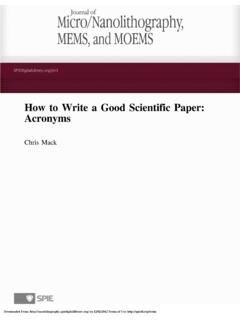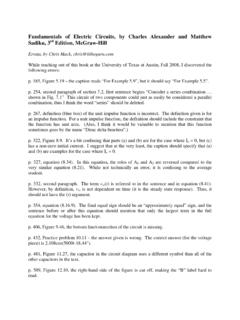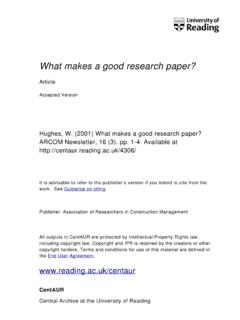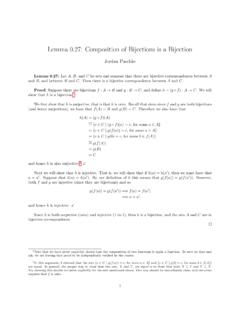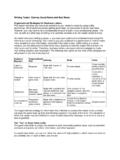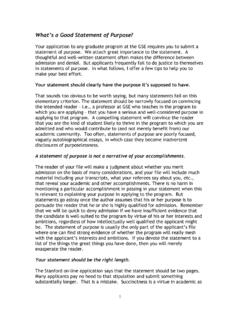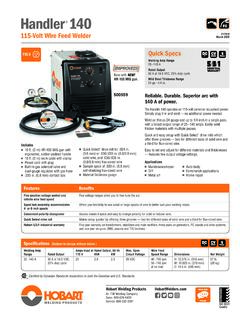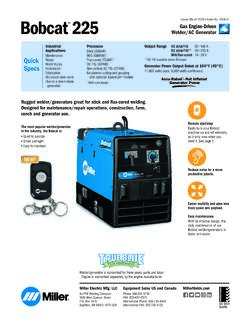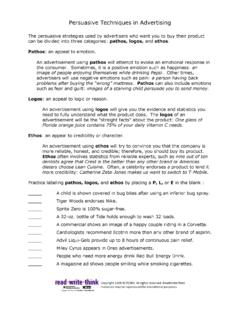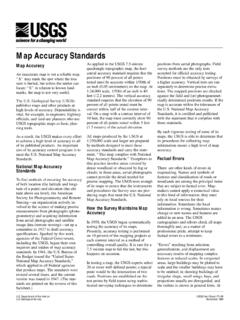Transcription of How to Write a Good Scientific Paper: Structure and ...
1 How to Write a good ScientificPaper: Structure and OrganizationChris MackDownloaded From: on 12/02/2014 Terms of Use: to Write a good ScientificPaper: Structure andOrganizationWriting is inherently a creative process. That would seem agood fit for the science researcher, where creativity coupledwith critical thinking is the key to success. Alas, many scien-tists do not think of themselves as qualified writers, some find-ing the task of writing both intimidating and arduous. For thosereaders who are not already experienced at writing articles forscience journals, I have a secret to share: you don t have to bea good writer to Write a good science paper. The reason isthis: there is a formula for how to Structure and organize a sci-entific paper, so that the scientist/writer can focus on whatthey know best the science and worry less about formula for writing?
2 That may sound like a recipe formediocrity, and in some contexts this would surely be for the science paper, the emphasis must always stayon the science, with the words mere tools for effectively con-veying information. Over the last 350 years Scientific journalshave evolved a distinctive style, Structure , and organizationthat makes it easy for both the writer and the reader to getwhat they need from the paper: effective communication ofscientific major difference between journal-based science writingand the many diverse forms of writing found elsewhere is thevery limited scope of our medium. A science paper does nothave to be all things to all people. It is a narrow genre with anarrow (though very important) purpose. A specific scientificcommunity (say, the readership of JM3) is not a random sam-pling of humanity, but a group that shares an established andunderstood basic Scientific background, a broadly agreed-upon set of common goals, and an already established setof mechanisms for the communication of information.
3 By fol-lowing the standard (I won t quite say preferred) Structure andorganization of a science research article, the author is con-strained in many respects. But these constraints free theauthor and the reader to focus on the content, which oftenresults in a better The Standard Structure of a Scientific PaperThe vast majority of papers published in Scientific journalstoday follow a fairly simple Structure . With some variations,most papers use an IMRaD format:1. Introduction2. Method (experiment, theory, design, model)3. Results and Discussion4. ConclusionsThis format is so ubiquitous that it is often surprising to seea paper that significantly deviates from it. Of course, there aremany variations on this theme, and the Structure is meant toadvance the goal of communication, never hinder it. There aretwo main advantages of following the IMRaD Structure : itmakes it easier on the writer to organize the content of thepaper, and it makes it easier on the reader to opportunisticallyfind the information they are after.
4 Let s look at each of thesesections in more standard rhetoric, the introduction section should answertwo questions: What? and So what? What is the paperabout, and why should the reader care? The Scientific journalpaper is a specialized form of rhetoric and so we use a morespecialized format for our introduction, but answering thesetwo questions is still required. Thus, an introduction shouldinform the reader as to what the paper is about, and motivatethe reader to continue I mentioned in a previous editorial,1a paper must meetfour criteria before it is publishable in a Scientific journal: The content of the paper must match the scope of thejournal The quality of the paper (method and execution of theresearch, as well as the writing) must be sufficiently high It must present novel results (with the exception ofreview papers and the like) The results must be significant enough to be worth read-ing about (and thus worth publishing)Of these four criteria, the author should clearly lay claim tothree of these in the introduction (scope, novelty, and signifi-cance).
5 Quality is implied and should be demonstrated, notexplicitly basic flow of the Introduction is to start with the gen-eral, then move to the specific. As Swales has described it, theresearch article introduction moves through three phases2: Establish a territory (what is the field of the work, why isthis field important, what has already been done?) Establish a niche (indicate a gap, raise a question, orchallenge prior work in this territory) Occupy that niche (outline the purpose and announcethe present research; optionally summarize the results).An alternate formulation of these three parts of the intro-duction are: topic, problem, solution (for engineering); ortopic, observation/discovery, explanation (for science). Somearticles finish the Introduction by presenting an outline of thearticle, though I am not a fan of this style. The section head-ings themselves are more effective than creating a table ofcontents in prose Micro/Nanolith.
6 MEMS MOEMS040101-1 Oct Dec 2014 Vol. 13(4)EditorialDownloaded From: on 12/02/2014 Terms of Use: common pitfalls in writing an Introduction includeproviding unnecessary background information (telling thereader what they already know or what they don t need toknow), exaggerating the importance of the work, or failingto make clear what research questions this paper is tryingto Method section (sometimes called the Materials andMethod section) describes how the results were should be sufficiently detailed so that an independentresearcher working in the same field could reproduce theresults sufficiently to allow validation of the this does not require explicit step-by-step instructions,but rather references to prior publications that provide suchdetails. For some research articles, it is the method that isnovel. For this case, a much more detailed description isrequired.
7 For standard or well-established methods, namingthe method may be s parse the requirement for sufficient detail a littlemore carefully. There are really two interrelated goals at work:the reader should be given the ability to reproduce the results,and the ability to judge the very few readersattempt a replication of another s experiment, most carefulreaders attempt to judge the validity of the work they are read-ing about. Internal validity means the conclusions drawn aresupported by the results presented. External validity refers tothe degree that the conclusions can be generalized (ratherthan applicable just to the narrow confines of this onework). Without a carefully written Method section it becomesimpossible to assess the validity of the method is used here more broadly than an experimen-tal method. The method can include the development of atheory (either as necessary background or as a novel elementof the paper), the establishment of a specific device design, orthe development or description of a modeling tool to be common variation of the IMRaD Structure is to separate outthe theory (or design or modeling) into its own preceding sec-tion, then move on to the experimental good Method section should not only describe what wasdone and how it was done, but should justify the experimentaldesign as well.
8 Of the many options available, why was thismethod chosen? Statistical considerations, such as samplingplans and analysis methods used, should be explained. If theraw results are not going to be presented, then a description ofthe data reduction procedures is also required. Also, considerhow a figure or diagram might be used to illustrate or summa-rize the methods common shortcoming of Method sections in manypapers today is the abandonment of the goal of reproducibil-ity. Usually citing economy as the driving principle, Methodsections are often overly brief and lacking in detail. Rarelydoes a Method section explain why one approach was chosenover another. Nobody reproduces other people s work any-more, or so the thought goes. I find this attitude mistaken,and often self-serving. Some researchers may not want theirresults to be reproduced, and more to the point, may notwant the validity of their results to be questioned.
9 Othersmay want to hide necessary details for commercial the advancement of Scientific knowledge requires bothreproducibility and the ability to judge the quality and validityof published results. A thorough and detailed Method sectionis the first and most important step in achieving these common pitfalls when writing the Method section areto include results in the Method section, include extraneousdetails (unnecessary to enable reproducibility or judge valid-ity), or to treat the method as a chronological history of and DiscussionThe results of a paper, if included as its own section, shouldbe very short. It is simply a presentation of the results obtainedcorresponding to the methods described in the previous sec-tion, organized to make them accessible to the reader . Oftenthese results are presented in tables and/or graphs. Well-crafted tables and figures require very little in terms of sup-porting text in the body of the paper,4,5so the results are usu-ally combined with a discussion of them in the Results andDiscussion does not explain itself.
10 The purpose of theDiscussion section is to explain the results and show howthey help to answer the research questions posed in theIntroduction. This discussion generally passes through thestages of summarizing the results, discussing whether resultsare expected or unexpected, comparing these results to pre-vious work, interpreting and explaining the results (often bycomparison to a theory or model), and hypothesizing abouttheir Discussion section mirrors the format of theIntroduction, moving from the specific (the results generatedin this work) to the general (how these results demonstrate ageneral principle and are more widely applicable). Any prob-lems or shortcomings encountered during the course of thework should also be discussed, especially if they might influ-ence how results are to be common pitfalls when writing the Results andDiscussion section are a lack of organization, presentingresults that are never discussed, presenting discussion thatdoesn t relate to any of the results, presenting results and dis-cussion in chronological order rather than logical order, ignor-ing results that don t support the conclusions, or drawingconclusions from results without logical arguments to backthem Conclusion section provides a brief summary of theResults and Discussion, but it should be more than a sum-mary.
